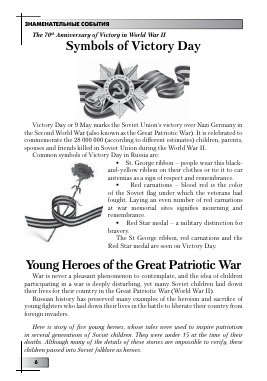The 70th Anniversary of Victory in World War II
Symbols of Victory Day
Victory Day or 9 May marks the Soviet Union's victory over Nazi Germany in the Second World War (also known as the Great Patriotic War). It is celebrated to commemorate the 28 000 000 (according to different estimates) children, parents, spouses and friends killed in Soviet Union during the World War II. Common symbols of Victory Day in Russia are:
■ St. George ribbon - people wear this black -and-yellow ribbon on their clothes or tie it to car antennas as a sign of respect and remembrance.
■ Red carnations - blood red is the color of the Soviet flag under which the veterans had fought. Laying an even number of red carnations at war memorial sites signifies mourning and remembrance.
■ Red Star medal - a military distinction for bravery.
The St George ribbon, red carnations and the Red Star medal are seen on Victory Day.
Young Heroes of the Great Patriotic War
War is never a pleasant phenomenon to contemplate, and the idea of children participating in a war is deeply disturbing, yet many Soviet children laid down their lives for their country in the Great Patriotic War (World War II).
Russian history has preserved many examples of the heroism and sacrifice of young fighters who laid down their lives in the battle to liberate their country from foreign invaders.
Here is story of five young heroes, whose tales were used to inspire patriotism in several generations of Soviet children. They were under 15 at the time of their deaths. Although many of the details of these stories are impossible to verify, these children passed into Soviet folklore as heroes.
Valya Kotik
Valya Kotik was a partisan scout and the youngest hero of the Soviet Union.
Valya Kotik worked on
collecting weapons and ammunition, and painted and pasted placards with caricatures of Nazis. In the fall of 1941, he carried out a real diversion - he set up an
ambush near a road, and with a grenade, he blew up a car carrying Nazis, killing several soldiers and the squad commander of the field gendarmerie.
From 1942, he participated in the partisan movement in Ukraine - he derailed trains and blew up warehouses. He died in 1944, at the age of 14, in the battle for the city of Izyaslav.
Marat Kazei
His father, a sailor in the Baltic Fleet, called him Marat, in honor of the battleship Marat. After the death of their parents, he and his sister became fighters in a partisan unit. Kazei successfully penetrated enemy garrisons in villages on many occasions, obtaining valuable information for scouts. He organized dozens of explosions on railway lines and participated in battles.
In 1944, in the village of Khoromitskie (Belarus), the partisan scouts were discovered by the Nazis. The Germans surrounded the boy, hoping to grab the scout alive. Marat shot back at the Germans, and when he ran out of ammunition, he blew himself up with a grenade. He was 14 years old.
Lara Mikheyenko
In the early summer of 1941, during her summer vacation, this Leningrad schoolgirl went to visit her grandmother in a village. After the war started, she found that she was unable to return home as the village she was living in had been captured by the Germans.
In the summer of 1943, Lara and a friend ran away to join a partisan unit, where she became a scout. She collected information about the number of German soldiers, locations of gun emplacements, and participated in the "railway line" war, derailing enemy trains.
In the fall of 1943, the 14-year-old girl was seized by the Nazis during a scouting expedition. During the interrogation, she tried to blow herself up with a grenade, which for some reason did not explode. After being severely tortured, she was shot by the Nazis.
Volodya Dubinin
When the war started, the 13-year-old schoolboy took shelter with a group of partisans in a quarry in Kerch (a city in Crimea). Volodya was the messenger and scout in this underground fortress.
For about two months, the invaders fought against the partisan group in the quarry, eventually cementing up all the exits. As Volodya was the smallest, he managed to get out to the surface through very narrow manholes, unnoticed by the enemy.
In January 1942, Kerch was liberated by soldiers of the Red Army. Sappers began to demine the area around the quarry, and Volodya volunteered to help them - he was killed after stepping on a mine.
Musya Pinkenzon
The only one of the five children that did not participate in the fighting and was never a partisan, his name has nonetheless become a symbol of courage for all child-heroes of the Great Patriotic War.
In the summer of 1942, the boy's family, being Jewish, were all arrested and sentenced to death. Together with others that were sentenced to death, they were taken to the Kuban River, where residents from the entire village were herded.
Musya, holding a violin, started playing "the Internationale" - the anthem of the Communists, which at that time was also the anthem of the Soviet Union. The song was immediately picked up by the residents of the village, and according to the story, the 11-year-old boy kept playing until the bullets cut him down. Souses http://rbth.com http://news.xinhnanet.com www.timeanddate.com
Составитель О.В. Полухина
Сведения о составителе: Полухина Ольга Викторовна, редактор журнала «Иностранные языки в школе», Москва. E-mail: editor@flsmozaika.ru
Ключевые слова: the 70th anniversary of victory in WW II, symbols of Victory Day, young heroes.
Для дальнейшего прочтения статьи необходимо приобрести полный текст. Статьи высылаются в формате PDF на указанную при оплате почту. Время доставки составляет менее 10 минут. Стоимость одной статьи — 150 рублей.
